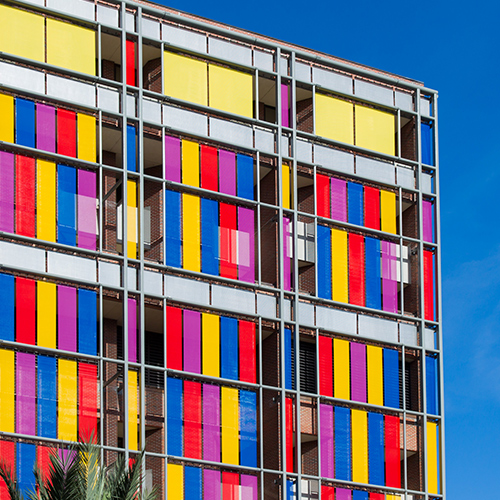Architectural Wire Mesh: Glossary and Key Terminology
Architectural wire mesh is a one-of-a-kind design material that was introduced to the world of architecture not too long ago. From parking garages to the interior of performance art centers, architectural mesh creates an unforgettable atmosphere that visitors will love.
That said, there is some basic knowledge you need to know in order to ensure your next project stands out.
W.S. Tyler’s team of experts have helped architects all over the globe incorporate wire mesh for over 20 years and are eager to provide you with the know-how needed to optimize your architectural design process.
In this article, we will provide insight into some key terminology that will help you better understand architectural mesh, define the different weave types, define the forms in which mesh is available, and what you can expect to receive when ordering an architectural mesh system.
Key Terminology
Warp: All wires running length wise in a roll of wire cloth. The name Warp wire comes from the fact that these are the wires that are fed into the weaving loom by the warp beam.
Weft/Shute: All wire running across the roll of wire cloth. These are the wires that are driven through the sets of warp wires by the rapier band during the weaving process.
Zero Aperture: The warp and weft wires in zero-aperture specifications lie as close as possible against each other.
Wire Diameter (d): The width of a given wire in the weave. Depending on the needs of your project, various wire diameters can be used in the same weave.
Open Area: is the percentage of the area of all apertures in the total surface area, or the ratio of the square of the nominal aperture width (w) to the square of the nominal pitch (p), rounded to a full percentage value.
Calendaring: The process of rolling woven wire mesh to a specified thickness while also creating a smooth surface.
Crimping: Sequenced curvature of a wire as a result of pre-deformation or weaving.
Pitch: the distance between the midpoints of two adjacent wires. Represents the sum of the aperture width (w) and wire diameter (d).
Mounting Terms
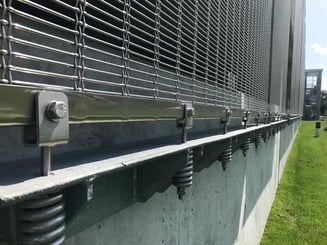 Substructure: The foundation of most wire mesh systems that is directly attached to the structure. The substructure is typically constructed out of galvanized steel (for extra corrosion resistance) and takes on an “L” shaped profile.
Substructure: The foundation of most wire mesh systems that is directly attached to the structure. The substructure is typically constructed out of galvanized steel (for extra corrosion resistance) and takes on an “L” shaped profile.
Clevis Hardware: Brackets that run along the top and bottom flat tension profiles of the mesh panels. These brackets are used to attach the mesh panels to the substructure.
Flat Tension Profile: The clamps located at the top and bottom of each panel used in the system. The flat tension profile is used to attach the mesh and clevis to each other.
Pressure Springs: Springs located at the bottom substructural frame that allows enough give to allow the mesh to flex to prevent damage when the wind hits it.
Intermediate Tube: Specifically placed support tubes the provide additional support throughout the length of the façade. They are designed to stop the panels from drifting, damaging the mesh.
Finishes
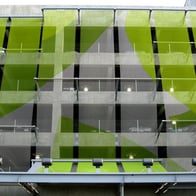 Paint: An automotive-grade paint that is applied to the surface of the wires. Architectural mesh can be painted in most colors and customized individual logos and patterns can be applied to reduce advertisement costs. Painting is also used to make the mesh have the aesthetic of another alloy, such as bronze.
Paint: An automotive-grade paint that is applied to the surface of the wires. Architectural mesh can be painted in most colors and customized individual logos and patterns can be applied to reduce advertisement costs. Painting is also used to make the mesh have the aesthetic of another alloy, such as bronze.
Digital Printing: The transferring of complex graphics and pictures to architectural wire mesh. The visibility of the graphics depends on the wire mesh pattern as well as the viewing distance. For exterior applications, a protective, UV-resistant coating is used to prevent the environmental elements from damaging the imagery.
Mesh Types
The term weave type refers to the way in which the warp and weft wires cross each other. It encompasses four different mesh categories: Woven wire, Cable, Fine, and Specialty.
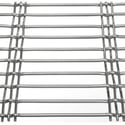 Woven wire: Wire mesh is best defined as an assortment of rigid wires that have been woven together to form a sheet of mesh that is interlaced.
Woven wire: Wire mesh is best defined as an assortment of rigid wires that have been woven together to form a sheet of mesh that is interlaced.
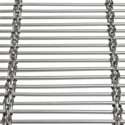 Cable Mesh: Cable mesh is a mesh type that is woven on a specialized weaving loom, much like woven wire. The key difference between the two is that cable mesh uses cables rather than stainless steel wires in the warp (vertical) direction.
Cable Mesh: Cable mesh is a mesh type that is woven on a specialized weaving loom, much like woven wire. The key difference between the two is that cable mesh uses cables rather than stainless steel wires in the warp (vertical) direction.
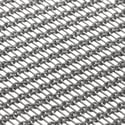 Fine Mesh: Mesh profiles that are constructed out of wires that have very small wire diameter. Fine mesh are particularly sensitive when introduced mechanical stresses. That said, the application of the mesh is a key factors when classifying fine mesh.
Fine Mesh: Mesh profiles that are constructed out of wires that have very small wire diameter. Fine mesh are particularly sensitive when introduced mechanical stresses. That said, the application of the mesh is a key factors when classifying fine mesh.
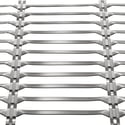 Specialty Mesh: Specialty mesh is mesh that features a unique pattern and carries the characteristic of employing several different wire types.
Specialty Mesh: Specialty mesh is mesh that features a unique pattern and carries the characteristic of employing several different wire types.
Forms
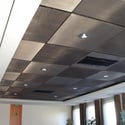 Cut-To-Size: Pre-cut mesh that the mesh supplier fabricates based on dimensions and quantities you specify.
Cut-To-Size: Pre-cut mesh that the mesh supplier fabricates based on dimensions and quantities you specify.
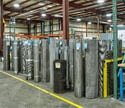 Mesh Rolls: Sheets of mesh, ranging from 100 feet up to 1,000 feet in length, that get wrapped around a cardboard tube for shipment. The length of the mesh is dependent on the dimensions and mesh profile
Mesh Rolls: Sheets of mesh, ranging from 100 feet up to 1,000 feet in length, that get wrapped around a cardboard tube for shipment. The length of the mesh is dependent on the dimensions and mesh profile
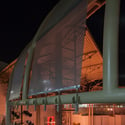 Ready-to-Install: Ready to install mesh is architectural mesh that fully fabricated so that the installers simply needs to attach it to the structure when it arrives.
Ready-to-Install: Ready to install mesh is architectural mesh that fully fabricated so that the installers simply needs to attach it to the structure when it arrives.
Service
All wire mesh façade systems come with everything you need to turn your vision into a reality. Each system includes:
• On-site delivery
- Mesh, mounting system, mounting hardware, intermediate tubes, etc.
- project-specific structural calculations
- shop drawings
- two redline revisions
- full engineering assistance
- on-site installation assistance
Step Into The World of Architectural Mesh
We hope this article helped you gain a better understanding of some of the terms you have been hearing when working with architectural mesh suppliers.
It is important to remember that with all the customization options available, the only limitation of architectural mesh is your imagination. That said, it is recommended that you enroll in an AIA presentation to expand your knowledge on the possibilities of architectural mesh while also earning CEU credits.
Having worked in the world of architectural design, W.S. Tyler is here to ensure you make the most out of your architectural mesh solutions.
To learn more about how AIA presentations can benefit you, refer to our article: Becoming an Architectural Mesh Expert With AIA CEU Presentations.
About Ronnie Brown
Ronnie is the Content Writer for W.S. Tyler and has four years of experience as a professional writer. He strives to expand his knowledge on all things particle analysis and woven wire mesh to leverage his exceptional writing and graphic design skills, creating a one-of-a-kind experience for customers.

